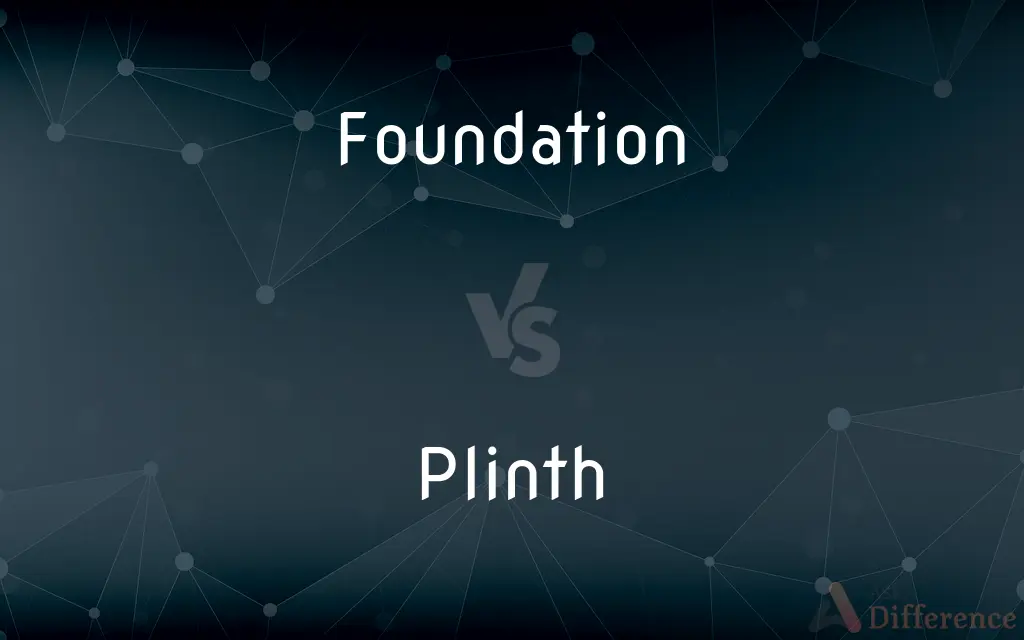Foundation vs. Plinth — What's the Difference?
By Tayyaba Rehman & Fiza Rafique — Updated on March 15, 2024
A foundation distributes a building's load to the ground, while a plinth raises a structure above its base, often for aesthetics.

Difference Between Foundation and Plinth
Table of Contents
ADVERTISEMENT
Key Differences
Foundation is a critical structural element in construction, designed to distribute the load of a building evenly across the ground, ensuring stability and preventing settlement. It's typically hidden underground and made from materials like concrete. On the other hand, a plinth serves both a practical and aesthetic role. It raises the structure above the ground to protect it from moisture and enhances its appearance. Plinths are visible and can be made from various materials, including stone and concrete.
Foundations are engineered based on the soil type, building load, and environmental conditions to prevent structural damage. They come in different types, such as shallow and deep foundations, each suited for specific circumstances. Plinths, however, are primarily concerned with elevating the structure for aesthetic reasons or to prevent water ingress. They are not designed to distribute loads but to support and highlight the structure they raise.
The construction of a foundation requires careful planning and often involves techniques like excavation and soil testing to ensure it can support the building's weight over time. This process is crucial for the long-term stability of a structure. Plinths, while also requiring careful design, are more about enhancing the visual appeal and utility of the base of a structure, and their construction is generally less complex.
While foundations are an essential part of any building, providing the necessary support to prevent uneven settling and potential collapse, plinths can also serve a protective role against environmental factors. However, their main function is often to elevate and embellish, making them a distinct element from foundations in purpose and design.
Despite their differences, both foundations and plinths are vital in construction. Foundations ensure a building’s longevity and safety, whereas plinths contribute to its visual appeal and can offer additional protection from moisture. Their combined use in construction can greatly enhance a building's functionality and aesthetics.
ADVERTISEMENT
Comparison Chart
Purpose
Distributes building load to ensure stability.
Raises structure above ground, often for aesthetics.
Visibility
Typically underground and not visible.
Visible and part of the building's exterior.
Material
Commonly made from concrete, steel.
Can be made from stone, concrete, or brick.
Design Consideration
Based on soil type, building load, environmental conditions.
Focused on aesthetics and protection from moisture.
Type
Includes shallow and deep foundations.
Can vary in height and design but not in function.
Compare with Definitions
Foundation
An underlying basis or principle for something.
Trust is the foundation of a strong relationship.
Plinth
A base or platform that supports a statue, vase, or structure.
The ancient statue stood on a marble plinth.
Foundation
A structure that transfers the load of a building to the earth.
The engineers designed a deep foundation to support the skyscraper.
Plinth
A heavy base supporting machinery or equipment.
The generator was mounted on a concrete plinth for stability.
Foundation
A charitable institution providing funds for research.
The foundation donated millions to cancer research.
Plinth
A base block that forms the foundation of a wall or column.
The plinth blocks were adorned with traditional motifs.
Foundation
The basis or groundwork of anything.
Good nutrition is the foundation of a healthy lifestyle.
Plinth
An architectural element that elevates a structure above ground.
The building’s plinth was designed to prevent flood damage.
Foundation
The lowest load-bearing part of a building.
The foundation was laid with reinforced concrete.
Plinth
The lower square slab at the base of a column.
The architect highlighted the plinth with intricate carvings.
Foundation
The lowest load-bearing part of a building, typically below ground level
Foundations were being dug for a block of flats
Build the arch resting on top of this solid foundation
Plinth
A block or slab on which a pedestal, column, or statue is placed.
Foundation
An underlying basis or principle
Physics, the foundation of all the sciences
Without stability, the country will not be able hold the elections that will lay the foundation for a peaceful and democratic future
This idea is the foundation of all modern economics
Plinth
The base block at the intersection of the baseboard and the vertical trim around an opening.
Foundation
The action of establishing an institution or organization
The foundation of a civil service college
Plinth
A continuous course of stones supporting a wall. Also called plinth course.
Foundation
The act of founding, especially the establishment of an institution with provisions for future maintenance.
Plinth
A square base, as for a vase.
Foundation
(Architecture) A wall or other structure, as of concrete or masonry, usually extending below ground level and forming the base upon which a building rests.
Plinth
A block or slab upon which a column, pedestal, statue or other structure is based.
Foundation
Something that gives rise to or supports something else.
Plinth
The bottom course of stones or bricks supporting a wall.
Foundation
The act of founding, fixing, establishing, or beginning to erect.
The foundation of his institute has been wrought with difficulty.
Plinth
A base or pedestal beneath a cabinet.
Foundation
That upon which anything is founded; that on which anything stands, and by which it is supported; the lowest and supporting layer of a superstructure; underbuilding.
Plinth
In classical architecture, a vertically faced member immediately below the circular base of a column; also, the lowest member of a pedestal; hence, in general, the lowest member of a base; a sub-base; a block upon which the moldings of an architrave or trim are stopped at the bottom. See Illust. of Column.
Foundation
(figurative) The result of the work to begin something; that which stabilizes and allows an enterprise or system to develop.
Plinth
An architectural support or base (as for a column or statue)
Foundation
(card games) In solitaire or patience games, one of the piles of cards that the player attempts to build, usually holding all cards of a suit in ascending order.
Foundation
(architecture) The lowest and supporting part or member of a wall, including the base course and footing courses; in a frame house, the whole substructure of masonry.
The foundations of this construction have been laid out.
Foundation
A donation or legacy appropriated to support a charitable institution, and constituting a permanent fund; endowment.
Foundation
That which is founded, or established by endowment; an endowed institution or charity.
The Wikimedia Foundation, Inc. is the parent organization of the Wiktionary collaborative project.
Foundation
(cosmetics) Cosmetic cream roughly skin-colored, designed to make the face appear uniform in color and texture.
Foundation
A basis for social bodies or intellectual disciplines.
Foundation
The act of founding, fixing, establishing, or beginning to erect.
Foundation
That upon which anything is founded; that on which anything stands, and by which it is supported; the lowest and supporting layer of a superstructure; groundwork; basis.
Behold, I lay in Zion, for a foundation, a stone . . . a precious corner stone, a sure foundation.
The foundation of a free common wealth.
Foundation
A donation or legacy appropriated to support a charitable institution, and constituting a permanent fund; endowment.
He was entered on the foundation of Westminster.
Foundation
That which is founded, or established by endowment; an endowed institution or charity; as, the Ford Foundation.
Against the canon laws of our foundation.
Foundation
The basis on which something is grounded;
There is little foundation for his objections
Foundation
An institution supported by an endowment
Foundation
The fundamental assumptions from which something is begun or developed or calculated or explained;
The whole argument rested on a basis of conjecture
Foundation
Lowest support of a structure;
It was built on a base of solid rock
He stood at the foot of the tower
Foundation
Education or instruction in the fundamentals of a field of knowledge;
He lacks the foundation necessary for advanced study
A good grounding in mathematics
Foundation
A woman's undergarment worn to give shape to the contours of the body
Common Curiosities
Are foundations always made of concrete?
While concrete is common, foundations can also be made of steel, stone, and other materials depending on the requirements.
How do plinths contribute to a building's design?
Plinths elevate the structure, enhancing its visual appeal and sometimes protecting it from environmental factors.
Can the absence of a proper foundation lead to structural issues?
Yes, without a proper foundation, buildings can suffer from uneven settling, cracks, and even collapse.
What is the primary purpose of a foundation?
To distribute the load of a building evenly across the ground, ensuring stability.
Can plinths be used for any practical purpose besides aesthetics?
Yes, plinths can protect structures from moisture and serve as bases for machinery.
Can every building have a plinth?
Technically, yes, but the inclusion of a plinth depends on the architectural design and purpose of the building.
How are plinths constructed?
Plinths are constructed using materials like stone, concrete, or brick, designed to elevate and sometimes protect the structure.
Is the plinth part of the foundation?
While a plinth can serve as a transitional element between the ground and the foundation, it is generally considered separate from the foundation.
How does soil testing influence foundation design?
Soil testing determines the soil's bearing capacity, guiding the foundation's design to ensure it can support the building's load.
Are plinths necessary for all structures?
Not necessarily, their use is often dictated by aesthetic, functional, or environmental considerations.
Why is the foundation considered the most critical part of a building?
It ensures the building's stability, longevity, and safety by evenly distributing its weight.
Do all buildings need a foundation?
Yes, all buildings require a foundation to ensure structural integrity and safety.
What is the difference between a shallow and deep foundation?
Shallow foundations spread the load over a large area at a shallow depth, while deep foundations transfer it to deeper, more stable layers.
Do foundations vary with soil type?
Yes, the design of a foundation takes into account the soil type to ensure stability and prevent settlement.
Can a foundation also serve as a plinth?
In some designs, the foundation might be visible and elevate the structure, serving a dual function, but typically they serve different purposes.
Share Your Discovery

Previous Comparison
Hm vs. Hmm
Next Comparison
Rubber vs. GumAuthor Spotlight
Written by
Tayyaba RehmanTayyaba Rehman is a distinguished writer, currently serving as a primary contributor to askdifference.com. As a researcher in semantics and etymology, Tayyaba's passion for the complexity of languages and their distinctions has found a perfect home on the platform. Tayyaba delves into the intricacies of language, distinguishing between commonly confused words and phrases, thereby providing clarity for readers worldwide.
Co-written by
Fiza RafiqueFiza Rafique is a skilled content writer at AskDifference.com, where she meticulously refines and enhances written pieces. Drawing from her vast editorial expertise, Fiza ensures clarity, accuracy, and precision in every article. Passionate about language, she continually seeks to elevate the quality of content for readers worldwide.














































